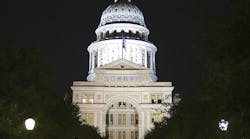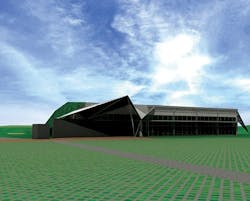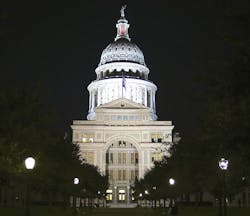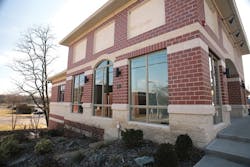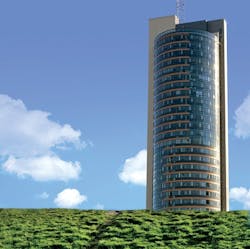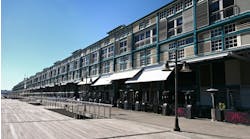Buildings Must Be Green to Compete
The results of two recent studies show that green buildings outperform non-green buildings in occupancy, sale price, and rental rates—sometimes by wide margins. Studies conducted by Bethesda, MD-based CoStar Group Inc. and the White Salmon, WA-based New Buildings Institute (NBI) indicate that property investors and tenants are looking for buildings that have earned LEED® certification or the ENERGY STAR® label because they're increasingly viewed as financially sound investments.
Ashley Katz, communications coordinator for the Washington, D.C.-based U.S. Green Building Council (USGBC), answers the following questions for Buildings readers.
Buildings: According to these studies, green buildings are outperforming their non-green equivalents in many key areas. How soon will green become the norm?
Katz: We're seeing an obvious market transformation already occurring. Currently, 3.2 billion square feet of commercial space are involved with LEED, and that number grows each day. Reports like the CoStar and NBI studies will convince project owners and managers that, if it's not green, it's not Class-A building space.
Buildings: At what point will it be uneconomical to not go green?Katz: It's already uneconomical to build the conventional way. Energy prices are soaring, and green buildings save 30 to 50 percent on energy, which can really reduce operating costs and energy bills. And, while many think that green building costs more, the upfront costs for a high-performance office building average only 1 to 2 percent of the overall budget. The average return on investment is 20 percent over the building's lifetime. Add in the health and productivity benefits for the building's occupants, and the benefits for the environment, and it's clear that green building makes both economic and environmental sense.
Buildings: How soon will owners and managers of green buildings see higher occupancy and rent rates?Katz: Both are immediate and often happen before the building is ready to open. In fact, a lot of high-rise office projects sell out quickly because the projects [are] marketed as green, and that has been shown to attract potential tenants right off the bat.
Buildings: Why is going green particularly important in today's economic environment?Katz: Green buildings are better for the bottom line - hands down. The USGBC used to tout the environmental benefits; now we talk about the business benefits - everything from reducing utility bills by 30 to 50 percent to using 40-percent less water. Those stats are just the hard, economic savings, but occupants are also healthier, happier, and more productive. In fact, employees in green buildings have fewer sick days and decreased turnover.
Companies like Pittsburgh-based PNC Bank (which has committed to build more than 170 LEED-certified bank branches), the Bank of America Tower in New York City (LEED Platinum), and Adobe (with LEED-certified corporate headquarters in San Jose, CA) are leading the way. They know it's better for the bottom line, and they have the competitive edge.
Cincinnati Superfund Site Goes Green
A pre-engineered steel building on a former Superfund site (the name given to the environmental program established to address abandoned hazardous-waste sites) has become a candidate for one of the highest LEED ratings possible.
Cincinnati's Megen Construction Co. helped turn a once-warehouse into a green visitor's center for the new Fernald Preserve, a 1,050-acre site that was home to a uranium-processing facility that supported the U.S. weapons program from 1952 to 1989. A $4.4 billion environmental clean-up project converted the site into a nature preserve now run by the U.S. Department of Energy's Office of Legacy Management.
The 10,800-square-foot facility, which has been undergoing a $3 million renovation since December 2007, is slated for LEED Gold certification. Creating an energy-efficient facility out of a 23-foot-tall metal warehouse was a challenge, but the creative reuse of materials contributed to the project's eco-friendliness. "For instance," says Jim Kilpatrick, project manager at Megen, "the concrete removed from the old warehouse floor was used for erosion prevention, and recycled steel was used to reinforce new concrete poured on the site."
Other features of the facility include a geothermal heating and cooling system that reduces energy consumption by 48.5 percent per year, natural light and the use of motion detectors on lighting fixtures, high-efficiency plumbing fixtures, and a bio-wetland on the site that will process all of the building's wastewater. The center, which opens this summer, also includes a unique solstice wall that aligns the sun's position perfectly with the building's entrance on the morning of the summer solstice.
BIM Addition to ConsensusDOCS Creates New Industry Standard
A groundbreaking contract document - the Building Information Modeling (BIM) Addendum - has been added to the ConsensusDOCS catalog by the Arlington, VA-based Associated General Contractors of America (AGC).
The BIM Addendum is the first industry standard document to globally address the legal uncertainties associated with using BIM. The addition will be published by the end of June, providing a tool to utilize BIM from start to finish and to allow contractors to more closely integrate project delivery with owners and design professionals.
Austin Joins LED City™ Program
The City of Austin, TX, has joined the LED City program, an international initiative to deploy and promote energy-efficient LED lighting. Austin joins Toronto; Raleigh, NC; and Ann Arbor, MI, in evaluating and using state-of-the-art LED lighting technology across their municipal infrastructures.
In late 2007, the City of Austin and Austin Energy retrofitted one level of the One Texas Center Parking Garage with 47-watt LED fixtures. LEDs have also been installed in the hallway at Austin Energy headquarters, in streetlights on Barton Springs, in the Palmer Events Center marquee sign, and in the water fountain at the new Palmer Events Center Park. Additional installations are planned throughout the city.
According to the U.S. Department of Energy, 22 percent of electricity used in the United States powers lighting. Energy-efficient LEDs, and the cities that are making a commitment to use them, can help lower energy prices and promote sustainability.
Aging Baby Boomers Drive Healthcare Demand
Aging Baby Boomers and their increasing demands for medical services will fuel demand for healthcare properties over the next decade, according to a recent report from Santa Ana, CA-based Grubb & Ellis Co. As a result, medical properties are positioned to outperform other property types over the next 10 years.
Already, medical office space is outpacing traditional office space, as measured by asking rental rates. According to the report, from 2000 to 2007, asking rental rates for medical office space grew by an average of 2.8 percent per year, while rents for traditional office space grew by an average of 1.3 percent.
The 65-and-older age group is projected to grow by 36 percent between 2010 and 2020, compared with a growth of 9 percent for the general population, according to the U.S. Census Bureau. This, among other factors, will propel growth of health-related occupations at about twice the rate of general employment growth over the next decade, generating tenant and owner-user demand for healthcare properties.
Medical offices and other types of healthcare real estate are expected to weather soft economic conditions better than other property types due to the recession-resistant, noncyclical nature of healthcare demand among consumers.
New Jersey Surgery Center Nears Completion
The Hackensack Surgery Center in Hackensack, NJ, is one of the newest freestanding outpatient surgical centers in the state. The 6,316-square-foot building incorporates Class-A, Class-B, and Class-C operating rooms, as well as three nurse stations and rooms for pre-op, post-op, and anesthesia.
Designed by Fair Lawn, NJ-based Ives, Schier, & Lesser Architecture Studio (IS&L), the center was built upon the skeleton of a 1950s-era building. The facility is equipped to handle same-day procedures for multiple specialties, and was designed with accessibility in mind, featuring exterior entries to both levels of the building without the need for elevators or stairs.
The size of the pre-existing structure and the shape of the hill presented unusual challenges for the renovation, and parking structures and entrances had to be situated above and below the facility. Deciding on the rectangular shape of the facility was another challenge. Ken Schier, partner at IS&L, says, "Most surgery centers are designed in a square configuration due to Department of Health requirements to minimize the distance between nurse stations and operating rooms. The Department of Health was impressed that we were able to meet their standards with a rectangular design."
IFMA Report Reveals Cost Trends
IFMA's recently released Benchmarks V breaks down annual facility costs into a number of categories (including janitorial, maintenance, utility, security, environmental, space planning, emergency and disaster planning, projects, leases, and more) on a dollar-per-square-foot basis.
More than 1,000 facilities contributed to the report, which shows that facility costs run an average of $20.61 per square foot and $6,604 per occupant annually. The report also indicates that utility costs have risen as expected, but electricity consumption has decreased in some cases, perhaps due to sustainable and energy-efficient products and practices.
Office of High-Performance Green Buildings Established
An Office of High-Performance Green Buildings has been established by the U.S. General Services Administration (GSA) to ensure that all federal buildings meet sustainable design and energy-reduction targets mandated by the Energy Independence and Security Act of 2007. This newly created office will work in conjunction with the U.S. Department of Energy's office.
The Energy Independence and Security Act of 2007 required the GSA to establish an Office of High-Performance Green Buildings, which will work toward:
Reviewing current energy-reduction measures used in lighting, heating, and cooling federal buildings.
Developing a process to ensure that any energy-conservation measure employed in a major building renovation uses the most energy-efficient designs, systems, and equipment.
Ensuring that all leases are in buildings that have earned the ENERGY STAR label.
Ensuring that all new buildings and major renovations are designed to reduce fuel consumption by 55 percent.
Office Market Remains Tight in Q1 and is Expected to Slow
The United States office market recorded slightly negative net absorption for the first time since the last economic downturn, with a modest, 0.25-percent decline in occupancy across major office markets. According to the first-quarter report and highlights from Chicago-based Jones Lang LaSalle, the demand slowdown was significantly more widespread geographically in the first quarter of 2008 than in late 2007, with more than two-thirds of major markets experiencing occupancy declines led by major markets in Florida, Cleveland, New York City, Los Angeles, and Atlanta.
Markets remained tight, historically speaking, but overall vacancy inched upward to 14.3 percent in the first quarter from a cyclical low of 13.6 percent at year-end. The completion of more than 10 million square feet of new construction during the quarter contributed to the vacancy increase, with 66 million square feet of office development under way. Average rental rates have held firm, though, buoyed partially by high-priced new construction entering the market.
Research Reveals Increased Interest in Energy Efficiency
New research commissioned by Milwaukee-based Johnson Controls Inc. shows that executives continue to focus on energy efficiency. Nearly 72 percent of organizations pay more attention to energy efficiency than they did just 1 year ago. The percentage of companies expecting to make energy-efficiency improvements, however, has remained constant.
Some interesting expectations were noted by the survey. Nearly 40 percent of respondents believe it's extremely or very likely that, within the next 2 years, legislation will mandate energy efficiency and/or carbon reduction. Also, approximately 31 percent believe that green buildings will be extremely or very important in attracting and retaining future employees.
College Report Card Grades Sustainability
The College Sustainability Report Card 2008 from the Cambridge, MA-based Sustainable Endowments Institute (SEI) evaluates and compares campus and endowment sustainability activities at 200 colleges and universities across the United States and Canada.
Some interesting findings from the report:
- Schools are taking on climate change through aggressive carbon-reduction commitments. More than 25 percent of these schools have committed to achieving carbon neutrality in the long term by signing the American College & University Presidents Climate Commitment.
- Green-building policies are becoming more widespread. The percentage of schools with green-building policies increased from 48 to 69 percent.
- Campus sustainability initiatives outshine endowment sustainability activity.
- Schools perform best in the Food & Recycling category (one of eight categories in which these schools are graded). A remarkable 70 percent of schools devote at least a portion of food budgets to buying from local producers.
- More than one in three schools has full-time staff dedicated to sustainability. Currently, 37 percent report having dedicated sustainability staff, and several other schools have announced imminent hiring plans.
The complete report can be downloaded at SEI's website (www.endowmentinstitute.org/sustainability).
Thin-Film Solar Cell Competes with Silicon Efficiency
Researchers at the U.S. Department of Energy's National Renewable Energy Laboratory (NREL) have moved closer to creating a thin-film solar cell that can compete with the efficiency of the more common silicon-based solar cell. This accomplishment could herald new solar technology and products for commercial building owners who are interested in using renewable energy resources.
The copper indium gallium diselenide (CIGS) thin-film solar cell recently reached 19.9-percent efficiency - a new record for this type of cell. Multicrystalline silicon-based solar cells have shown efficiencies as high as 20.3 percent. The energy-conversion efficiency of a solar cell is the percentage of sunlight converted by the cell into electricity.
CIGS cells use extremely thin layers of semiconductor material applied to a low-cost backing, such as glass, flexible metallic foils, high-temperature polymers, or stainless-steel sheets. Thin-film cells require less energy to make and can be fabricated by a variety of processes, thus potentially providing more affordable solar cells for commercial, residential, and other uses.
The CIGS cells are of interest in space applications and the portable electronics market because of their light weight. They are also suitable in special architectural uses, such as photovoltaic roof shingles, windows, siding, and others.
Sustainable Flooring is Better for IAQ
Recent studies indicate that sustainable flooring, such as cork oak, bamboo, or certified hardwoods, can contribute to better indoor air quality (IAQ). A study supported by the National Institute of Environmental Health Sciences (NIEHS) shows that bacterial chemicals (endotoxins) are found particularly in indoor areas, with the highest concentrations found on floors.
A U.S. Environmental Protection Agency study found that some types of low-VOC sustainable flooring can help protect the quality of indoor air.
Traditional flooring is often stained or made fire resistant with products that can emit harmful VOCs or fumes, so be sure to choose flooring that doesn't use formaldehyde glue or binders, and that has been off-gassed in the factory. Choosing sustainable flooring products and avoiding harmful emissions can improve your building's IAQ and help you achieve LEED points.
